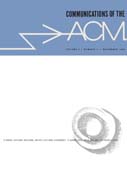Data filtering applied to information storage and retrieval applications
Manipulation of data strings is the most complex processing function in information storage and retrieval applications. Data string manipulation is discussed within the context of an interpretive processing environment controlled by the use of procedural directives. The sequence of procedural directives is derived from a job assumed to be expressed in a user-oriented source language.
Each data string within the structured data environment (data bank) is explicitly or implicitly related to a format declaration residing in a format library. The processing mechanics associated with data string manipulation is developed in accordance with a generalized data filtering concept. This results in the implementation of a two-port data filter module that satisfies internal processing functions by filtering data strings through format declarations associated with its input and output ports.




